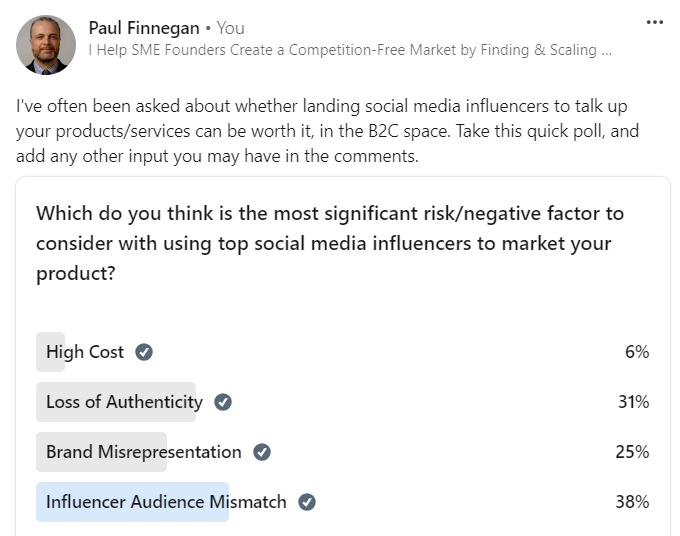I recently conducted a poll on LinkedIn.
The results are shown in the graphic above.
LinkedIn doesn’t seem to have a good way of exporting the poll results. Or maybe it does but such a method didn’t readily present itself. And that’s fine. Or maybe it is staring me in the face, and I keep missing it! 🙂
Anyway, here’s the poll and the results analyzed (kind of):
Question:
Which do you think is the most significant risk/negative factor to consider with using top social media influencers to market your product?
Answer(s):
1) High Cost 6%
2) Loss of Authenticity 31%
3) Brand Misrepresentation 25%
4) Influencer Audience Mismatch 38%
(Well, this is all quite clear in the graphic, but I thought I’d trot it out here too.)
My takeaways:
- Concerns over cost were far outweighed by the other choices, especially where loss of control of the brand message might arise (choices 2 and 3). (It would be interesting to see if there is a shift on this when it actually comes to pulling out the checkbook.)
- Picking the wrong influencer is a significant fear (audience mismatch), as it should be.
Another thing I wanted to query specifically was whether an influencer can be spread across too many paid partnerships, representing too many brands. But I couldn’t, since a LinkedIn poll only gives you four choices. But.. I am thinking ‘Loss of Authenticity’ encompasses this.
The poll also gathered some worthy comments:
“People don’t have a problem when a company (like Calvin Klein) pay top dollar to a personality/model (like David Beckham) to represent their product and brand – they carefully select someone who represents their target market and who will appeal to target market. This has been common practice for many years – yet use the word ‘social media influencer’ and this brings up opinions of inauthenticity etc. I believe you CAN match a social media influencer to a brand through research and have seen great ROI on ‘micro influencers’ for boutiques, hairdressers etc as well as for more established influencers and bigger businesses.”
–Gaye Moore
“In my experience, leveraging social media influencers in the B2C space can be highly effective, BUT it’s not without its pitfalls. I’ve seen firsthand how brand misrepresentation can occur when influencers aren’t carefully vetted or don’t fully understand the brand they’re promoting. It’s essential to do your homework and choose influencers who genuinely resonate with your brand’s values and target audience. That said, I still feel that being authentic and building a solid reputation by listening to your current clients and leveraging user-generated content (UGC) is often more effective. UGC tends to be more relatable and trustworthy, fostering a genuine connection with your audience.”
–Maggie Carey
“In my own experience when it comes to business-to-business (B2B) marketing, the people who use your services and products are the real influencers. That’s why testimonials and video testimonials can go a long way. The other thing is that in the B2B space, people are usually looking to build a long-term relationship with you, or there may be a higher buy-in, so they want to hear from real people/businesses who have used that product or service. Almost all social media influencers tend to work in the B2C space, so marketing a restaurant or launching a face cream or coffee etc is a strategy that can and does work. But what I love about B2B is the authenticity and that the ordinary person can influence the purchasing decision.”
–Martin Murtagh
“We are in the process of hiring influencers for a new campaign. Your post is very timely for us, thank you. Finding the right person and voice with a great match of their audience with our target audience has driven the search.”
–John O’Brien
My next poll (PART B) will query the positives of using social media influencers!

